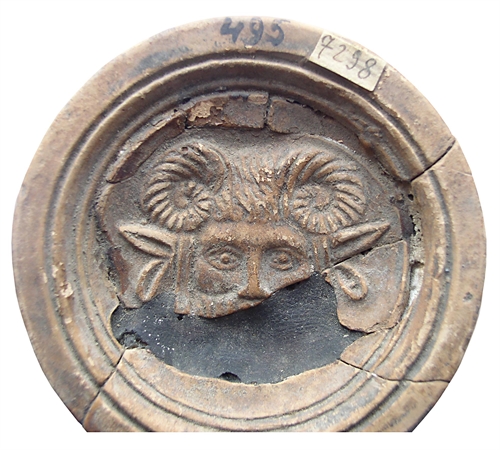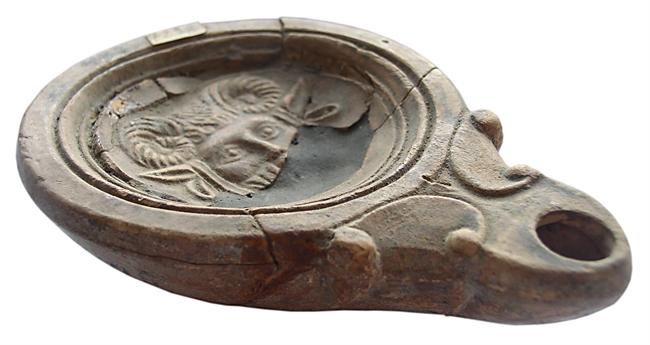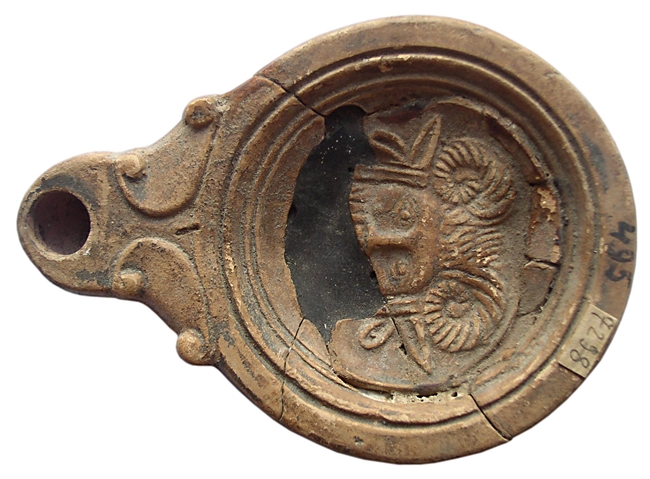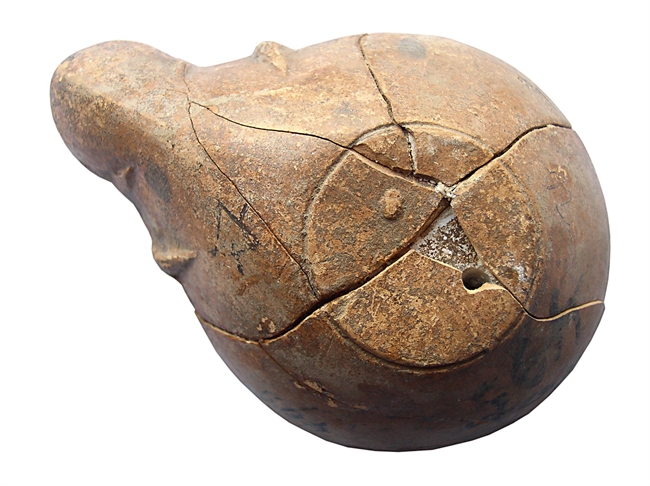Oil-lamp with an image of Jupiter-Ammon

The oil-lamp is finely rendered. Its nozzle features a special decorative motif. The central medallion, inside triple moulding, contains an iconographically unusual porttrayal of male deity whose lower part of the head is missing due to the damage. Large ram horns made by a motif resembling a line indicates that this is in fact Jupiter-Ammon. Between the horns, there is stylized hair formed diagonally with parallel lines. The long, straight nose and small eyes can be seen on the preserved part of the face, while at the edge of the breakage point, to the right of the nose, the remains of a beard are notable, also made of parallel lines. This unusual motif could be called double ears which jut from both sides of the face, leaning against two parallel lines. It is difficult to accept B. Perc's assertion (1968:90) that the oil-lčamp probably served for rituals in the temple of Isis (Iseum) in Nin. It is much more likely that it had a funereal purpose. This is also confirmed by the find site, as well as the most frequent burial role of oil-lamps bearing images of Egyptian deities. In the book Izidin trag, I expressed doubt that this was an oil-lamp which was designated as a find from Zadar (1997:53 1.9), which should be corrected.
Catalogue entry
Oil-lamp from terracotta with an image of Jupiter-Ammon
Archaeological Museum Zadar, Zadar
Inv. no. AMZd A-10179; old inv. nos. I.e.7298, L.495
Nin (Aenona)
Roman Empire, 1st-3rd c. A.D.
terracotta: baked earth, moulding
2.9 x 11.4 x 8.05 cm
Resources
- Budischovsky, Marie-Christine. La Diffusion des cultes isaiques autour de la mer Adriatique. I: Inscriptions et monuments. [EPRO 61]. Leiden, 1977. 177.
- Perc, Bernarda. Beiträge zur Verbreitung ägyptischer Kulte auf dem Balkan und in den Donauländern zur Römerzeit : mit besonderer Berücksicksihtingung des Quellenmaterials aus dem Gebiet des heutigen Staates Jugoslawien. [Doktorska disertacija]. München, 1968. 90.
- Selem, Petar. "Aegyptiaca". U: Selem, Petar; Vilogorac Brčić, Inga. ROMIC I. Religionum Orientalium monumenta et inscriptiones ex Croatia I. Zagreb, 2015: 7-62. no. 24, 33.
- Selem, Petar. Izidin trag. Egipatski kultni spomenici u rimskom Iliriku. Split, 1997. no. 1.9, 53=1.15, 58?
- Selem, Petar. Lica bogova. [Izabrana djela Petra Selema, knjiga 1]. Zagreb, 2008. no. 85, 144.
- Tomorad, Mladen. „The Ancient Egyptian Antiquities in Institutional and Private Collections in Croatia“. U: Tomorad, Mladen (ur.). A History of Research into Ancient Egyptian Culture conducted in Southeast Europe. Oxford, 2015: 31-58. 49, fn. 59.
- Tomorad, Mladen. „The Ancient Egyptian Collections in Croatia and the Project Croato-Aegyptica Electronica“. U: Derriks, Claire (ur.). Collections at risk: New Challenges in a New Environment - Proceedings of the 29th CIPEG Annual Meeting in Brussels, September 25-28, 2012, Royal Museums of Art and History Brussels, Belgium. Atlanta, 2017: 237-268. 256, fn. 63.
- Tomorad, Mladen. „The Egyptian antiquities in Croatia“. PalArch 2, 1 (2005): 1-33. 20.
- Tomorad, Mladen. „The phases of penetration and diffusion of Egyptian artefacts and cults in the region of Istria and Illyricum (from the 7th c. B.C. to the 4th c. A.D.)“. U: Györy, Hedvig (ur.). Aegyptus et Pannonia V. Budapest, 2016: 185-226 + Plates 69-81. 192, 196, 198.
- Tomorad, Mladen. Egipat u Hrvatskoj: egipatske starine u hrvatskoj znanosti i kulturi. Zagreb, 2003. 51-52, fn. 228.
- Tomorad, Mladen. Model računalne obrade i prezentacije staroegipatskih predmeta u muzejskim zbirkama u Hrvatskoj. [Doktorska disertacije, Filozofski fakultet u Zagrebu Sveučilišta u Zagrebu]. Zagreb, 2006. 27.
- Tomorad, Mladen. Staroegipatska civilizacija, sv. II: Uvod u egiptološke studije. Zagreb, 2017. 80.





